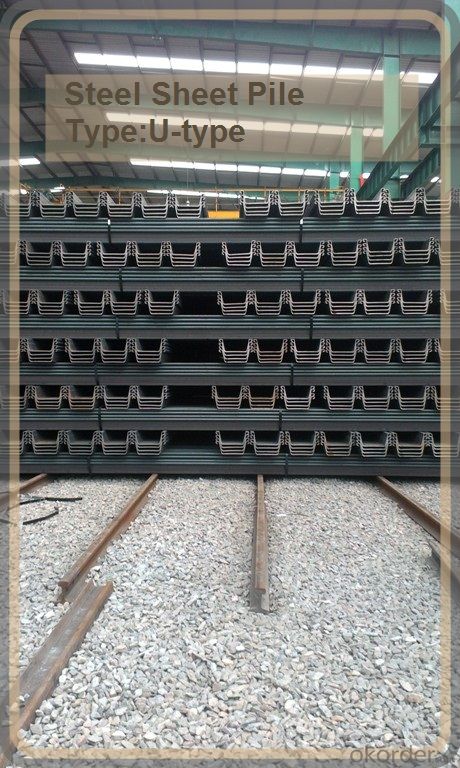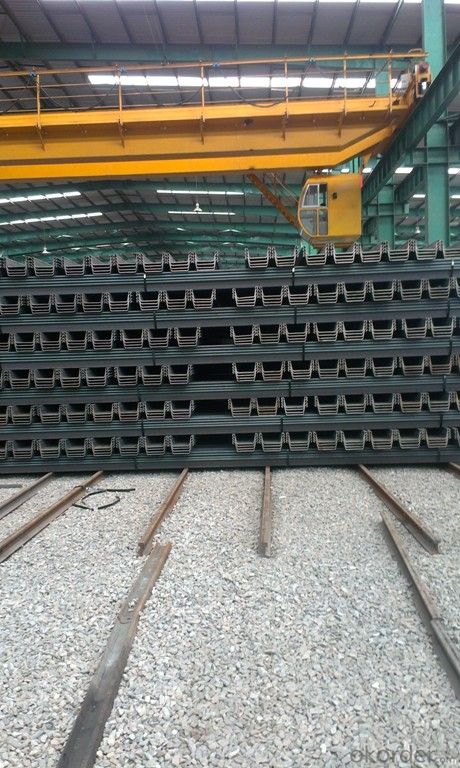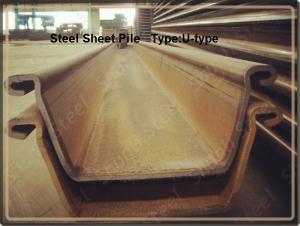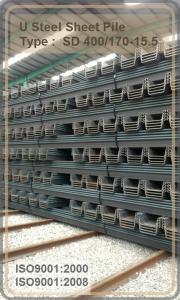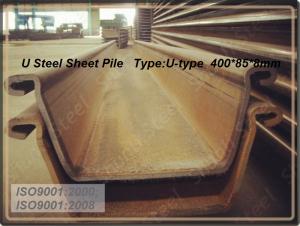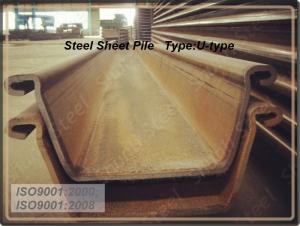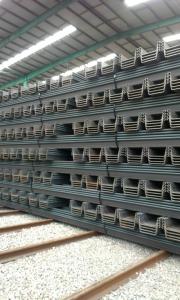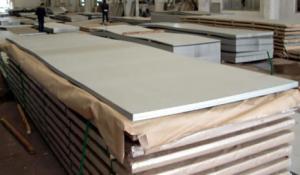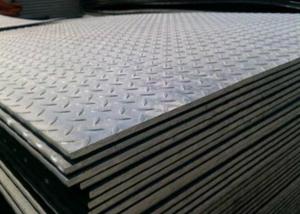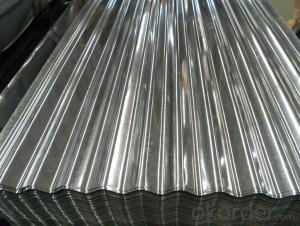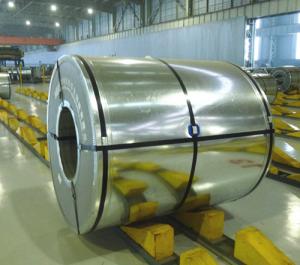Export Steel Sheet Pile/U Steel Sheet Pile/ 500*200*24.3mm
- Loading Port:
- China Main Port
- Payment Terms:
- TT or LC
- Min Order Qty:
- 200 Piece/Pieces m.t.
- Supply Capability:
- 10000 m.t./month
OKorder Service Pledge
OKorder Financial Service
You Might Also Like
Quick Details for Steel Sheet Piles
Place of Origin: China (Mainland)
Model Number: SD500/200-24.3
Material: Steel
Product name: Steel Sheet Pile
Steel sheet pile type: U-type
Steel sheet pile material: SY295
Steel sheet pile width: 500mm
Steel sheet pile height: 200mm
Steel sheet pile thickness: 24.3mm
Steel sheet pile length: 6m or 12m
Steel sheet pile loading: container , 20 ft or 40GP
Steel sheet pile used: temporary earth-retaining,temporary cofferdam works
Steel sheet pile weight: 105kgs / m
Packaging & Delivery
| Packaging Details: | packaging :by bulk . loading : container 20ft or 40GP |
|---|---|
| Delivery Detail: | stock ( more type has stock ) |
Export U Steel Sheet Pile 500*200*24.3mm
Product Description
Steel Sheet Pile Usage
temporary earth-retaining, temporary cofferdam works and permanent structures
Steel Sheet Pile Type : SD 500/200-24.3
Type | Size | Per piece | Per Meter of pile wall | ||||||||
Width | Height | Thickness | weight | section area | section moment | section modulus | section area | section moment | section modulus | weight | |
mm | mm | mm | kgs /m | cm2 | cm4 | cm3 | cm²/m | cm4/m | Cm³/m | kg/m² | |
SD500/200-24.3 | 500 | 200 | 24.3 | 105 | 133.8 | 7960 | 520 | 267.6 | 63000 | 3150 | 210 |
SD500/225-27.6 | 500 | 225 | 27.6 | 120 | 153 | 11400 | 680 | 306 | 86000 | 3820 | 2 |
Packaging & Shipping
Packing : it use container to load , 6M use 20ft container ; 12M use 40GP container .
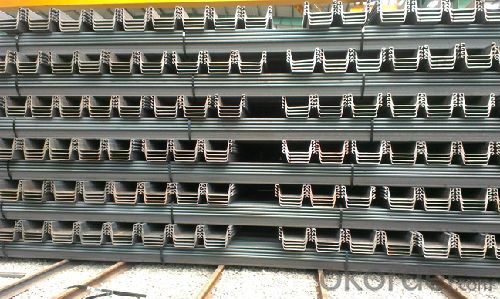
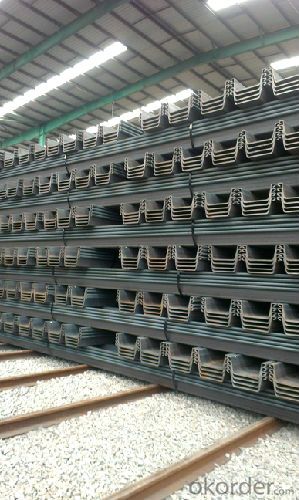
Our Services
World leading manufacturer of cold-formed Sheet Pile.
Factory got a variety of quality certification : ISO9001:2000; ISO9001:2008.
Our products popular applicated for temporary earth-retaining, temporary cofferdam works and permanent structures
- Q: What are the different quality standards for steel sheets?
- There are several different quality standards for steel sheets, including ASTM (American Society for Testing and Materials), AISI (American Iron and Steel Institute), JIS (Japanese Industrial Standards), and EN (European Norms). These standards outline specific requirements for various aspects of steel sheets, such as chemical composition, mechanical properties, dimensional tolerances, and surface finish. Compliance with these standards ensures that steel sheets meet certain quality and performance criteria and can be used for specific applications in various industries.
- Q: What is the fatigue strength of steel sheets?
- The fatigue strength of steel sheets refers to their ability to withstand repeated cyclic loading or stress without failure. It varies depending on factors such as the steel grade, surface condition, and thickness of the sheets.
- Q: Are steel sheets fire resistant?
- Yes, steel sheets are fire resistant as they have a high melting point and do not contribute to the spread of fire.
- Q: Can steel sheets be used for shipping containers?
- Yes, steel sheets can be used for shipping containers.
- Q: Do steel sheets have any environmental benefits?
- Steel sheets possess numerous environmental advantages. Firstly, steel is an immensely recyclable material, allowing for multiple reuses without compromising its quality. This notably diminishes the necessity for new steel production, subsequently reducing the extraction of raw materials and the energy consumption associated with manufacturing. Additionally, recycling steel aids in the reduction of greenhouse gas emissions and the preservation of natural resources. Moreover, steel sheets exhibit exceptional durability and longevity. Their high resistance to corrosion means they require minimal maintenance throughout their lifespan. This durability lessens the need for frequent replacements, ultimately decreasing the demand for new steel production and its accompanying environmental impact. Furthermore, steel sheets can contribute to energy efficiency in buildings. When utilized as roofing or cladding material, they provide excellent insulation properties, effectively reducing the requirements for heating and cooling energy. Consequently, this leads to lower energy consumption and a reduced carbon footprint. Additionally, steel sheets possess fire-resistant qualities, thereby enhancing building safety and minimizing the risk of fire-related accidents. This aspect positively impacts the environment by minimizing the release of harmful emissions and pollutants resulting from fires. In conclusion, steel sheets present a range of environmental benefits, encompassing recyclability, durability, energy efficiency, and fire resistance. These attributes contribute to a more sustainable and eco-friendly approach within the construction and manufacturing industries.
- Q: How are steel sheets protected during transportation by sea?
- Steel sheets are protected during transportation by sea through various measures such as applying corrosion-resistant coatings, packing them in moisture-proof and weather-resistant materials, securing them with appropriate lashing and bracing, and using specialized shipping containers or vessels equipped with proper ventilation and humidity control systems. These measures ensure that the steel sheets remain intact, free from rust, and undamaged throughout the sea voyage.
- Q: Can steel sheets be used in high-temperature applications?
- Yes, steel sheets can be used in high-temperature applications due to their excellent heat resistance properties. Steel sheets are commonly used in industries such as automotive, aerospace, and manufacturing where high temperatures are encountered.
- Q: What is the difference between a perforated and non-perforated steel sheet?
- The main difference between a perforated and non-perforated steel sheet lies in their respective designs and functionalities. A perforated steel sheet is characterized by having small holes or perforations evenly distributed throughout its surface. These holes can be of different shapes and sizes, depending on the specific application requirements. The primary purpose of a perforated steel sheet is to allow for the passage of air, light, sound, and liquids through the sheet, while still maintaining its structural integrity. This makes it highly suitable for applications where ventilation, filtration, or visibility is essential. Perforated steel sheets are commonly used in industries such as architecture, automotive, manufacturing, and construction, where they are employed for various purposes, including acoustic panels, protective barriers, decorative elements, and filter screens. On the other hand, a non-perforated steel sheet does not have any holes or perforations on its surface. It is a solid sheet of steel that is typically used for applications where strength, durability, and resistance to impact or abrasion are important factors. Non-perforated steel sheets are often utilized in structural engineering, machinery, shipbuilding, and heavy-duty equipment manufacturing, as they provide a solid and reliable surface for load-bearing and other demanding applications. In summary, the difference between a perforated and non-perforated steel sheet lies in their design and functionality. Perforated steel sheets have small holes throughout their surface, allowing for the passage of air, light, sound, and liquids, while non-perforated steel sheets are solid sheets without any holes, providing strength and durability for heavy-duty applications.
- Q: Are steel sheets suitable for modular construction?
- Yes, steel sheets are highly suitable for modular construction due to their durability, strength, and versatility. They offer excellent structural integrity, making them ideal for constructing prefabricated modules that can be easily transported and assembled on-site. Additionally, steel sheets can be customized to meet various design requirements, enabling the creation of aesthetically appealing and functional modular buildings.
- Q: How do steel sheets compare to plastic sheets?
- Steel sheets are generally stronger, more durable, and have a higher heat resistance compared to plastic sheets. They are better suited for heavy-duty applications, such as construction and industrial uses, where strength and durability are crucial. Plastic sheets, on the other hand, are lightweight, flexible, and cost-effective. They are commonly used for applications where weight and cost are important factors, such as packaging, signage, and some consumer goods. Ultimately, the choice between steel and plastic sheets depends on the specific requirements and intended use of the sheets.
Send your message to us
Export Steel Sheet Pile/U Steel Sheet Pile/ 500*200*24.3mm
- Loading Port:
- China Main Port
- Payment Terms:
- TT or LC
- Min Order Qty:
- 200 Piece/Pieces m.t.
- Supply Capability:
- 10000 m.t./month
OKorder Service Pledge
OKorder Financial Service
Similar products
Hot products
Hot Searches
Related keywords



